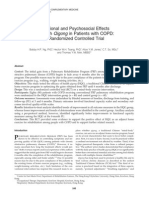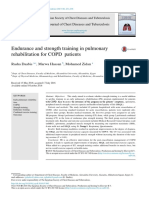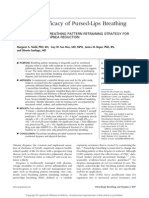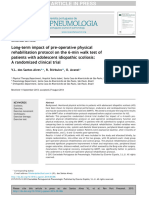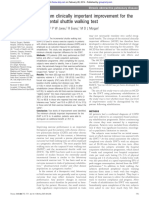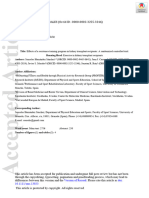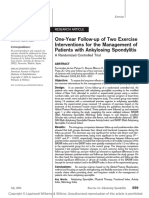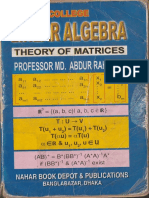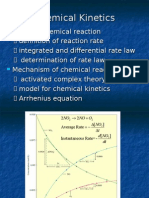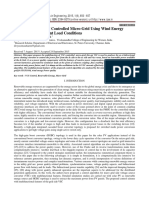Epoc 4
Epoc 4
Uploaded by
Cristian FerradaCopyright:
Available Formats
Epoc 4
Epoc 4
Uploaded by
Cristian FerradaOriginal Title
Copyright
Available Formats
Share this document
Did you find this document useful?
Is this content inappropriate?
Copyright:
Available Formats
Epoc 4
Epoc 4
Uploaded by
Cristian FerradaCopyright:
Available Formats
ORIGINAL ARTICLES
Effects of Muscle Training on Breathing Pattern in Patients With Severe Chronic Obstructive Pulmonary Disease
J.M. Ruiz de Oa Lacasta,a J. Garca de Pedro,b L. Puente Maestu,b D. Llorente Iigo,b J. Celdrn Gil,a and J.M. Cubillo Marcosb
a b
Unidad de Gestin Clnica de Neumologa, Hospital Nuestra Seora del Prado, Talavera de la Reina, Toledo, Spain. Servicio de Neumologa, Hospital General Universitario Gregorio Maran, Madrid, Spain.
OBJECTIVE: During physical exertion, the ventilatory response of patients with severe chronic obstructive pulmonary disease (COPD) is more rapid and shallow than that of healthy subjects. There is evidence that exercise training can alter breathing pattern in COPD patients. The purpose of the present study was to observe the effects of physical training on patients with severe COPD and to determine whether or not any possible changes were maintained over time. MATERIAL AND METHODS: Patients with severe COPD without bronchial reversibility were enrolled in a randomized controlled trial of a peripheral muscle training program carried out in a hospital setting. All enrolled patients were clinically stable, without exacerbation, and were randomly assigned to a training program of high (group A) or low (group B) intensity. RESULTS: Thirty-five men with severe COPD in stable condition (mean [SD] forced expiratory volume in 1 second at 41%[7%]) were enrolled in the study. The mean age was 64(5) years. Group A underwent training at 70(22) W and group B at 35(10) W, such that the estimated total work was 8050(2882) kJ in group A and 4044(1205) kJ in group B. Breathing pattern changes were detected in exercise tests only for group A patients, but the changes were not maintained 12 months after the end of the program. CONCLUSIONS: Intense training produces changes in the breathing pattern of patients with severe COPD. The changes are not specific to the task performed, not dependent on lactate production, and not maintained over the long term.
Key words: Chronic obstructive pulmonary disease (COPD). Ventilation. Exercise test.
Efectos del entrenamiento muscular sobre el patrn ventilatorio en pacientes con enfermedad pulmonar obstructiva crnica grave
OBJETIVO: Durante el esfuerzo fsico la respuesta ventilatoria de los enfermos con enfermedad pulmonar obstructiva crnica (EPOC) grave es ms rpida y superficial que la de los sujetos sanos, y existen indicios de que el entrenamiento fsico podra cambiar el patrn ventilatorio de estos pacientes. El propsito del presente estudio fue comprobar los efectos que el entrenamiento fsico de los pacientes con EPOC grave tiene sobre el patrn ventilatorio, as como determinar o no el mantenimiento de los posibles cambios producidos en el tiempo. MATERIAL Y MTODO: Se realiz un estudio aleatorio y controlado con pacientes con EPOC grave sin reversibilidad bronquial. En estos pacientes se efectu una intervencin mediante entrenamiento fsico. Los pacientes fueron remitidos al hospital para entrenamiento muscular perifrico, todos ellos en situacin clnica estable, sin exacerbacin, y fueron asignados a dos programas diferentes de entrenamiento fsico. RESULTADOS: Se estudiaron 35 pacientes varones con EPOC grave, estables (volumen espiratorio forzado en el primer segundo del 41 7%), con una edad media de 64 5 aos, divididos en dos grupos con diferente potencia media estimada de entrenamiento (grupo A: 70 22 W; grupo B: 35 10 W) y trabajo total desarrollado (grupo A: 8.050 2.882 kJ; grupo B: 4.044 1.205 kJ). Slo se objetivaron cambios en el patrn ventilatorio durante el ejercicio realizado durante la prueba de esfuerzo en el grupo A, que no se mantuvieron a los 12 meses de finalizado el programa. CONCLUSIONES: El entrenamiento intenso produce cambios en el patrn ventilatorio de los pacientes con EPOC grave que son inespecficos de la tarea e independientes de la produccin de lactato, y que no se mantienen a largo plazo.
Palabras clave: Enfermedad pulmonar obstructiva crnica (EPOC). Ventilacin. Prueba de esfuerzo.
Introduction
Correspondence: Dr. J.M. Ruiz de Oa Lacasta. Unidad de Gestin Clnica de Neumologa. Hospital Nuestra Seora Sra. del Prado. Ctra. de Madrid, km 114. 45600 Talavera de la Reina. Toledo. Espaa. E-mail: jmruiz@separ.es Manuscript received May 5, 2003. Accepted for publication July 1, 2003.
The exercise capacity of patients with chronic airflow limitationor chronic obstructive pulmonary disease (COPD)is often reduced, particularly in those with functional limitation at maximal effort.1 The
20
Arch Bronconeumol 2004;40(1):20-3
RUIZ DE OA LACASTA JM, ET AL. EFFECTS OF MUSCLE TRAINING ON BREATHING PATTERN IN PATIENTS WITH SEVERE CHRONIC OBSTRUCTIVE PULMONARY DISEASE
symptom that most often limits physical exercise in such patients is dyspnea.2 Patients with COPD develop altered ventilatory mechanics leading to dynamic hyperinflation,3 and there is solid evidence supporting the hypothesis that such hyperinflation contributes to reducing exercise tolerance.4,5 The ventilatory response of such patients during physical exercise is faster and more superficial than it is in healthy controls, contributing to greater dynamic hyperinflation.6 Muscle training of patients with COPD has been shown to improve response to exercise, capacity, and stamina and also to enhance cell metabolism in skeletal muscles.7 Certain indications suggest that training might also change respiratory pattern in COPD patients, improving efficiency.8 Our aim was to determine the effects that skeletal muscle training has on the respiratory pattern of patients with severe COPD and to observe whether possible changes are preserved over the long term.
Material and Method
This randomized controlled trial enrolled severe COPD patients (limitation defined by a ratio of forced expiratory volume in 1 second [FEV1] to forced vital capacity [FVC] less than 70% of predicted with FEV1 less than 50% of predicted). The enrolled patients bronchial obstruction was not reversible and they had not smoked in the 6 months before enrollment. The intervention consisted of a physical exercise program. The patients were referred to hospital for the program in stable condition, without exacerbation, and were assigned randomly to 2 muscle training regimens. Exclusion criteria were a history of ischemic heart disease or other diagnoses that would contraindicate performance of a stress test. The study was approved by the hospitals Ethics Committee and all patients signed informed consent forms. Once enrolled in the trial, all patients underwent physical examination, electrocardiography, and spirometry. Spirometry was performed in accordance with the recommendations of the Spanish Society of Pulmonology and Thoracic Surgery (SEPAR),9 using a Pneumoscreen II (Erich Jaeger GmBH, Hochberg, Germany). FEV1 and FEV1/FVC were recorded 15 minutes after inhaling 200 g of salbutamol. No subjects had bronchial reversibility. During a second visit, each patient underwent progressive exercise testing on a treadmill, limited by symptoms 10 according to the protocol of Balke . and Ware to estimate maximum oxygen consumption (V O2max) and peak minute ventilation. Ventilation and gas exchange were measured during the test using an Oxycom (Erich Jaeger GmBH). The patients were randomly assigned to one of 2 treatment groups. Group A underwent more intense training under supervision on a treadmill for 8 weeks, 4 days per week, beginning at a level equal to the anaerobic threshold reached plus 25% of the difference between that intensity and the maximum intensity ( 25%), which was then increased in keeping with the patients tolerance. Group B underwent less intense training, in a self-supervised program, walking 3 or 4 km in 1 hour, monitored by a pedometer for 8 weeks, 5 days per week.
Before and after training patients in.both groups performed a cycle ergometer test at 50% of the VO2max measured during the previous progressive exercise test. This continuous exercise test was thus carried out below the patients anaerobic threshold, such that oxygen uptake increased less than 50 mL/min during the interval between 4 and 10 minutes of testing and that there was no increase of lactic acid concentration above 2.5 mmol/L in circulating blood. Immediately after the muscle-training period, we studied changes in respiratory function variables in both groups. Later we studied whether changes persisted over time (12 months) in both groups. Patients in both groups were given periodic physical examinations (every 3 months) and all were encouraged to continue exercising. Twelve months after ending the training program, the patients underwent another submaximal continuous exercise test for recording ventilatory function variables. We compared the 12-month results within each group to the results obtained before and just after the peripheral muscle training program. We also compared the 12-month results between groups. Mean results recorded before and after muscle training were compared using a Student t test for paired data, after confirming that differences were normally distributed. Means for each group were compared using a Student t test for unpaired data, and a t test for unequal variances was used for two-tailed comparisons. Means were considered significantly different when the probability of a type I error was less than 0.05 for a two-tailed test. Statistical analysis was carried out using the SPSS package (version 7.5; Hispanoportuguesa SPSS, SL, Madrid, Spain) on a personal computer.
Results Thirty-five men with severe but stable COPD (mean FEV1 41% [SD 7%]), with a mean age of 64 (5) years were studied. Patient characteristics were similar, as were lung function variables at rest and during exercise, with the exception of mean estimated intensity of training (group A: 70 [22] W; group B: 35 [10] W) and total work (group A: 8050 [2882] kJ; group B: 4044 [1205] kJ). The patients exercise capacity was moderately reduced, as estimated by oxygen uptake in the progressive exercise test. Table 1 shows patient characteristics. Exercise test performance changed after muscle training in relation to type of training undergone (Table 2). Breathing pattern changes were seen during continuous exercise testing in group A . in expiratory . minute ventilation (V E), the ratio of V E to maximal voluntary ventilation (MVV) expressed as a percentage, respiratory rate, tidal volume, and the ratio of physiological dead space to tidal volume. Changes in breathing pattern observed immediately after the muscle training period in the high intensity training group were not maintained over time; a year after finishing the training program, those changes had disappeared and the breathing pattern in group A was similar to what it was before the study as well as similar to the pattern in the low intensity group (group B) after training.
Arch Bronconeumol 2004;40(1):20-3
21
RUIZ DE OA LACASTA JM, ET AL. EFFECTS OF MUSCLE TRAINING ON BREATHING PATTERN IN PATIENTS WITH SEVERE CHRONIC OBSTRUCTIVE PULMONARY DISEASE
TABLE 1 Patient Characteristics and Lung Function Variables*
Variable Self-Supervised (n = 17) Mean (SD) Supervised (n = 18) Mean (SD)
Age, years Height, cm Weight, kg FEV1, mL FEV1, % FEV1/FVC, % FVC, mL PaO2, mm Hg PaCO2, mm Hg DLCO, mmolmin1kPa1 DLCO% predicted, % KCO, mmolmin1kPaL1 KCO% predicted, % . V . O2max, mL/min VO2max % predicted, % Mean training intensity, W Total work, kJ
63.4 (4.8) 163.3 (4.8) 69 (8.1) 1087 (160) 41 (7.1) 45 (8.3) 2596 (484) 67.5 (5.4) 37.9 (2.6) 4.8 (1.6) 62.2 (19.7) 1.2 (0.4) 77.6 (33.9) 1247 (264) 59.1 (11.6) 35.1 (10.4) 4044 (1205)
65.8 (5.7) 164.9 (5.7) 68.5 (12.6) 1090 (161) 40.4 (7.5) 47 (8.7) 2560 (690) 62.8 (8.5) 37.7 (3.3) 5.2 (1.7) 66.7 (21.5) 1.1 (0.4) 77.7 (29) 1200 (350) 61 (18.1) 69.8 (22.3) 8050 (2882)
*FVC indicates forced vital capacity; FEV1, forced expiratory volume in 1 second; DLCO, carbon monoxide diffusing capacity; KCO, DLCO divided by alveolar volume; . VO2max, peak oxygen uptake.P<.0001.
TABLE 2 Changes Observed in Respiratory Variables During Continuous Exercise Testing, Before and After the Muscle Training Program in the High and Low Intensity Groups*
High Intensity Variables Before After P Before After P Low Intensity
. V . E, L/min VE/MVV, % RR, min1) VT, mL VD/VT Lactic acid in blood, mmol/L
29.4 (5.7) 65.4 (11.8) 27.2 (4.0) 1090 (211) 0.37 (0.10) 2.17 (0.27)
27.5 (5.8) 60.7 (9.2) 24.1 (4.3) 1156 (204) 0.34 (0.10) 2.18 (0.28)
<.05 <.05 <.01 <.05 <.05 NS
27.4 (6.2) 65.3 (14.5) 25.8 (4.2) 1077 (237) 0.36 (0.09) 2.23 (0.40)
26.5 (6.5) 61.9 (11.2) 26.1 (7.8) 1062 (313) 0.37 (0.12) 2.29 (0.38)
NS NS NS NS NS NS
. . . *Results are expressed as means with SD between parentheses. VE indicates expiratory minute ventilation; VE/MVV, ventilatory reserve, or VE as a percentage of maximal voluntary ventilation; RR, respiratory rate; VT, tidal volume; VD/VT, ratio of physiologic dead space to tidal volume.
Discussion Two interesting findings come from this study of muscle training in patients with severe COPD. First, we saw that high intensity muscle training in such patients changes breathing pattern during submaximal exercise, with breathing becoming slower, deeper, and in consequence, more efficient (with less dead space). Patients who trained at a lower intensity, on the other hand, showed no such change. Second, those beneficial effects on breathing pattern during exercise disappeared after the high intensity training came to an end, such that the patient returned to a situation that was similar to the one that prevailed before the muscle training program began. These findings suggest that high intensity muscle training, as opposed to less intense exercise, seems to induce beneficial changes in breathing pattern during exercise. Unlike normal subjects, COPD patients can increase tidal volume only slightly in response to
22
Arch Bronconeumol 2004;40(1):20-3
ventilatory demand, given that COPD patients breathe at high lung volume levels, such that increasing that volume further would suppose a disproportionate decrease in static and dynamic compliance, an increase of respiratory muscle effort, and more work of breathing.11,12 Because total lung capacity does not change with exercise, the only way to increase minute ventilation is to increase respiratory rate.13,14 Our patients who trained at high intensity increased minute ventilation and decreased respiratory rate during exercise, whereas those who underwent less intense training did not. Dyspnea is the symptom that is mostly responsible for limited exercise capacity in patients with COPD.2 Several studies have shown that some patients benefit from muscle training. Among treatments, muscle training has proven to be a valid tool for improving symptoms of dyspnea, quality of life, and capacity for exercise in these patients.15,16 However, the mechanisms that reduce dyspnea have not been fully elucidated, and
RUIZ DE OA LACASTA JM, ET AL. EFFECTS OF MUSCLE TRAINING ON BREATHING PATTERN IN PATIENTS WITH SEVERE CHRONIC OBSTRUCTIVE PULMONARY DISEASE
it has been suggested that increased tolerance to exercise must be responsible for improvements. Our results indicate that a possible mechanism would be a change in breathing pattern and the foreseeable reduction in dynamic hyperinflation. This effect seems to be independent of the intensity. An interesting finding from our study is that the changes observed seem to be independent of the type of task that was performed, given that the submaximal exercise tests were carried out on a cycle ergometer, even though the patients trained on a treadmill. We observed changes in variables measured during the first exercise test (before muscle training) and the second (after training) (Table 2). The breathing pattern changes seen during continuous exercise in. the high . intensity group (group A), in terms of both VE and VE/MMV, as well as respiratory rate and tidal volume or the ratio of physiological dead space to tidal volume (all of which take place without changes in lactic acidemia), suggest that such changes in ventilatory pattern do not depend on the amount of lactic acid produced and allow us to say that the effort made by the patients was submaximal. On the other hand, the patients who trained at low intensity (group B) had no changes in ventilatory variables. Patients with COPD have altered ventilation and pulmonary mechanics during exercise, with a prolonged time of exhalation and higher respiratory rate leading to dynamic hyperinflation with increased end-expiratory pressure and greater work of breathing. This is to say, the pulmonary hyperinflation of these patients increases inspiratory work and the sensation of dyspnea, although this pattern is essential if a COPD patient is to increase ventilation to adapt to the demands of exercise.17 Changes in breathing pattern occurring after physical exercise have been demonstrated before now,5,18 as have changes in ventilatory efficiency.19,20 Our findings, however, are the first to demonstrate that the changes related to the intensity of muscle training disappear over time. Based on these findings, we think that muscle training in severely ill COPD patients is a tool that will help improve exercise tolerance, owing to decreased perception of dyspnea related to decreased dynamic hyperinflation in response to exercise, which must be intense and continued over the long term. In conclusion, intense training produces changes in the breathing pattern of patients with severe COPD (in the form of deeper and less rapid breathing). The changes lead to greater efficacy and less ventilatory demand in these patients when they engage in submaximal exercise. This effect does not depend on the reduction of lactic acid and is unrelated to task. However, once these effects on ventilatory pattern are achieved, they are not maintained 12 months after ending intense training, such that the characteristics of
breathing pattern regress to similar levels as those that existed in these patients before participation in the intense physical training program.
REFERENCES 1. Killian KJ, Leblanc P, Martin DH, Summers E, Jones NL, Campbell EJM. Exercise capacity and ventilatory, circulatory, and symptom limitation in patients with chronic airflow limitation. Am Rev Respir Dis 1992;146:935-40. 2. Mahler DA. Clinical evaluation of exertional dyspnea. In: Clinics in chest medicine. Vol. 15. Philadelphia: Saunders Co., 1994; p. 259-69. 3. ODonnell DE, Sanii R, Anthonisen NR, Younes M. Effect of dynamic airway compression on breathing pattern and respiratory sensation in severe chronic obstructive pulmonary disease. Am Rev Respir Dis 1987;135:912-8. 4. Marn JM, Carrizo SJ, Gascn M, Snchez A, Gallego B, Celli BR. Inspiratory capacity, dynamic hyperinflation, breathlessness, and exercise performance during the 6-minutes-walk test in chronic obstructive pulmonary disease. Am J Respir Crit Care Med 2001;163:1395-9. 5. ODonnell DE, Webb KA. Exertional breathlessness in patients with chronic airflow limitation. The role of hyperinflation. Am Rev Respir Dis 1993;148:1351-7. 6. Gallagher CG. Exercise limitation and clinical exercise testing in chronic obstructive pulmonary disease. In: Clinics in chest medicine. Vol. 15. Philadelphia: Saunders Co., 1994; p. 305-26. 7. Casaburi R, Porszasz J, Burns MR, Carithers ER, Chang RSY, Cooper C. Physiologic benefits of exercise training in rehabilitation of patients with severe chronic obstructive pulmonary disease. Am J Respir Crit Care Med 1997;155:1541-51. 8. Puente-Maestu L, Sanz ML, Sanz P, Ruiz de Oa JM, RodrguezHermosa JL, Whipp BJ. Effects of two types of training on pulmonary and cardiac responses to moderate exercise in patients with COPD. Eur Respir J 2000;15:1026-32. 9. Grupo de trabajo de la Sociedad Espaola de Patologa Respiratoria (SEPAR) para la prctica de la espirometra clnica. Normativa para la espirometra forzada. Barcelona: Doyma, 1985. 10. Balke B, Ware R. An experimental study of physical fitness of Air Force personnel. US Armed Forces Med J 1959;10:675-88. 11. ODonnell DE. Breathlessness in patients with chronic airflow limitation. Mechanisms and management. Chest 1994;106:904-12. 12. ODonnell DE, Webb KA. Breathlessness in patients with severe chronic airflow limitation: physiologic correlations. Chest 1992; 102:824-31. 13. Yang S, Kaminski D, Sliwinski P. Reliability of inspiratory capacity for estimating end-expiratory lung volume changes during exercise in patients with chronic pulmonary obstructive disease. Am J Respi Crit Care Med 1997;156:55-9. 14. Montes de Oca M, Rassulo J, Celli BR. Respiratory muscle and cardiopulmonary function during exercise in very severe COPD. Am J Respir Crit Care Med 1996;154:1284-9. 15. ACCP/AACVPR Pulmonary Rehabilitation Guidelines Panel. Pulmonary rehabilitation. Joint ACCP/AACVPR Evidence-Based Guidelines. Chest 1997;112:1363-96. 16. Lacasse Y, Guyatt GH, Goldstein R. The components of a respiratory rehabilitation program. A systematic overview. Chest 1997; 111:1077-88. 17. Belman MJ. Exercise in patients with chronic obstructive pulmonary disease. Thorax 1993;48:936-46. 18. Woolf CR, Suero JT. Alterations in lung mechanics and gas exchange following training in chronic obstructive lung disease. Chest 1969;55:37-44. 19. Degre S, Sergysels R, Messin R, Vandermoten P, Slahadin P, Denloin H, et al. Hemodynamic responses to physical training in patients with chronic lung disease. Am Rev Respir Dis 1974;110: 395-402. 20. Clark CJ, Cochrane L, Mackay E. Low intensity peripheral muscle conditioning improves exercise tolerance and breathlessness in COPD. Eur Respir J 1996;9:2590-6.
Arch Bronconeumol 2004;40(1):20-3
23
You might also like
- Wr20 Book of Oblivion PDFDocument130 pagesWr20 Book of Oblivion PDFCristian Ferrada75% (8)
- Solution of Chapter 01 of Modern PhysicsDocument14 pagesSolution of Chapter 01 of Modern PhysicsHamza Hanif100% (1)
- Abb Focs Data Sheet Sensor Corriente PDFDocument2 pagesAbb Focs Data Sheet Sensor Corriente PDFdjsb00No ratings yet
- Energy Expenditure 2006Document7 pagesEnergy Expenditure 2006Niar MarhaliNo ratings yet
- Does Unsupported Upper Limb Exercise Training Improve Symptoms and Quality of Life For Patients With Chronic Obstructive Pulmonary Disease?Document6 pagesDoes Unsupported Upper Limb Exercise Training Improve Symptoms and Quality of Life For Patients With Chronic Obstructive Pulmonary Disease?R HariNo ratings yet
- Maintenance of Inspiratory Muscle Training in COPD Patients: One Year Follow-UpDocument5 pagesMaintenance of Inspiratory Muscle Training in COPD Patients: One Year Follow-UpGaoudam NatarajanNo ratings yet
- VonbankDocument7 pagesVonbanklsales1986oliNo ratings yet
- Neuromuscular Paper-Sierra MooreDocument7 pagesNeuromuscular Paper-Sierra Mooreapi-364421826No ratings yet
- Qigong and Cop DDocument11 pagesQigong and Cop DRodrigo EzequielNo ratings yet
- Endurance and Strength Training in Pulmonary Rehabilitation For COPD PatientsDocument6 pagesEndurance and Strength Training in Pulmonary Rehabilitation For COPD PatientsMuhammad RedhaNo ratings yet
- Endurance and Strength Training in Pulmonary Rehabilitation For COPD PatientsDocument6 pagesEndurance and Strength Training in Pulmonary Rehabilitation For COPD PatientsMuhammad RedhaNo ratings yet
- Efficacy of Pursed-Lips Breathing: A Breathing Pattern Retraining Strategy For Dyspnea ReductionDocument8 pagesEfficacy of Pursed-Lips Breathing: A Breathing Pattern Retraining Strategy For Dyspnea ReductionGaoudam NatarajanNo ratings yet
- Long Term Impact Preoperator...Document6 pagesLong Term Impact Preoperator...nistormaria492No ratings yet
- 1 s2.0 S0954611111004355 MainDocument7 pages1 s2.0 S0954611111004355 MainAnushka RaipureNo ratings yet
- Amira Permatasari Tarigan, Fannie Rizki Ananda, Pandiaman Pandia, Bintang YM Sinaga, Maryaningsih Maryaningsih, Anggriani AnggrianiDocument6 pagesAmira Permatasari Tarigan, Fannie Rizki Ananda, Pandiaman Pandia, Bintang YM Sinaga, Maryaningsih Maryaningsih, Anggriani AnggrianiDurratun NusrahNo ratings yet
- Af - EpocDocument8 pagesAf - EpocOladysMelizaHoyosParraNo ratings yet
- Benefits of High-Intensity Exercise Training To Patients With Chronic Obstructive Pulmonary Disease: A Controlled StudyDocument10 pagesBenefits of High-Intensity Exercise Training To Patients With Chronic Obstructive Pulmonary Disease: A Controlled StudyCésarNo ratings yet
- 24 Ashraf Et AlDocument7 pages24 Ashraf Et AleditorijmrhsNo ratings yet
- Tugas Farid PpokDocument9 pagesTugas Farid PpokUmmi AzizahNo ratings yet
- Minimum Clinically Important Improvement For The Incremental Shuttle Walking TestDocument4 pagesMinimum Clinically Important Improvement For The Incremental Shuttle Walking TestmavhelllinaNo ratings yet
- Research Article Telerehabilitation Using Fitness Application in Patients With Severe Cystic Fibrosis Awaiting Lung Transplant: A Pilot StudyDocument7 pagesResearch Article Telerehabilitation Using Fitness Application in Patients With Severe Cystic Fibrosis Awaiting Lung Transplant: A Pilot StudyBayu PrabuNo ratings yet
- Effect of Treadmill Exercise Training On VO Peak in Chronic Obstructive Pulmonary DiseaseDocument7 pagesEffect of Treadmill Exercise Training On VO Peak in Chronic Obstructive Pulmonary DiseaseAqila Zefanya AriefmanNo ratings yet
- Jurnal Massa Bebas LemakDocument10 pagesJurnal Massa Bebas Lemakmona nurdin nurdinNo ratings yet
- International Journal of Pharma and Bio Sciences: Research Article Human PhysiologyDocument6 pagesInternational Journal of Pharma and Bio Sciences: Research Article Human PhysiologyajenggayatriNo ratings yet
- Abstract BookDocument222 pagesAbstract BookArkesh PatnaikNo ratings yet
- Hsieh. Effects of High-Intensity Exercise Training in A Pulmonary Rehabilitation Programme For Patients With COPDDocument8 pagesHsieh. Effects of High-Intensity Exercise Training in A Pulmonary Rehabilitation Programme For Patients With COPDSofia MandolaNo ratings yet
- Hakala2000 PDFDocument7 pagesHakala2000 PDFVanshika GuptaNo ratings yet
- IntervalexercisetrialAnnals2006 PDFDocument12 pagesIntervalexercisetrialAnnals2006 PDFrunmenNo ratings yet
- Impact of Fan Therapy During Exercise On Breathlessness and Recovery Time in Patients With COPD, A Pilot Randomised Controlled Crossover TrialDocument13 pagesImpact of Fan Therapy During Exercise On Breathlessness and Recovery Time in Patients With COPD, A Pilot Randomised Controlled Crossover TrialAmirudin ChonNo ratings yet
- BMR 191803 PDFDocument10 pagesBMR 191803 PDFArchita AgarwalNo ratings yet
- Respiro Logy 2010Document5 pagesRespiro Logy 2010aabigutNo ratings yet
- Ijvm2012 985025Document8 pagesIjvm2012 985025NirmalaRamliNo ratings yet
- Copd 10 1703Document7 pagesCopd 10 1703brikitabelaNo ratings yet
- A Study of Efficiency of Breathing Exercises To Improve Pulmonary FX in SCi PtsDocument6 pagesA Study of Efficiency of Breathing Exercises To Improve Pulmonary FX in SCi PtsMarion AtienzaNo ratings yet
- Efektivitas Latihan Fisis Dan Latihan Pernapasan Pada Asma Persisten Sedang-BeratDocument8 pagesEfektivitas Latihan Fisis Dan Latihan Pernapasan Pada Asma Persisten Sedang-BeratikaNo ratings yet
- Indian Heart Journal: Original ArticleDocument5 pagesIndian Heart Journal: Original ArticleRendi KurniawanNo ratings yet
- MainDocument10 pagesMainMu RakimNo ratings yet
- Copd 10 1703Document7 pagesCopd 10 1703Maria Camila SanabriaNo ratings yet
- Aerobic Training, Muscle Stretching Jurnal 2Document10 pagesAerobic Training, Muscle Stretching Jurnal 2Bunga Mitra MampuNo ratings yet
- Journal2 BADocument11 pagesJournal2 BAJam BerNo ratings yet
- 10 1111@sms 13853Document17 pages10 1111@sms 13853Cintia BeatrizNo ratings yet
- Article Incentive SpirometryDocument8 pagesArticle Incentive SpirometryDeepak PatelNo ratings yet
- Physical Activity: and Self in Cystic FibrosisDocument6 pagesPhysical Activity: and Self in Cystic FibrosisSerian AdrianNo ratings yet
- Glittere AdlDocument8 pagesGlittere AdlsampathNo ratings yet
- Arm Exercise and Hyperinflation in Patients With COPD : Effect of Arm TrainingDocument8 pagesArm Exercise and Hyperinflation in Patients With COPD : Effect of Arm TrainingNaomiFettyNo ratings yet
- Ejercicio DiafragmaticoDocument3 pagesEjercicio DiafragmaticoN onlyNo ratings yet
- Jurnal Inter 2 - Slow Deep Breathing Exercise Menurunkan Tekanan DarahDocument6 pagesJurnal Inter 2 - Slow Deep Breathing Exercise Menurunkan Tekanan Darahfaizal arifNo ratings yet
- Jurnal CopdDocument11 pagesJurnal Copdgemarawan abadiNo ratings yet
- Copd Response of The Respiratory Muscles To Rehabilitation inDocument7 pagesCopd Response of The Respiratory Muscles To Rehabilitation inoanceaNo ratings yet
- 1 s2.0 S2531043718301107 MainDocument8 pages1 s2.0 S2531043718301107 MainCraniolyne RefianNo ratings yet
- Capacity (FVC) Pria Dewasa Denganoverweight: Pengaruh Latihan Aerobik Terhadap Forced VitalDocument6 pagesCapacity (FVC) Pria Dewasa Denganoverweight: Pengaruh Latihan Aerobik Terhadap Forced VitalKimbek BuangkeNo ratings yet
- Th. Wanke, D. Formanek, H. Lahrmann, H. Brath, M. Wild, Ch. Wagner, H. ZwickDocument7 pagesTh. Wanke, D. Formanek, H. Lahrmann, H. Brath, M. Wild, Ch. Wagner, H. Zwickrodrigokine777No ratings yet
- Nair 2019Document8 pagesNair 2019Anonymous VjiuWvATgNo ratings yet
- Medical Sciences: The Effects of Acute High-Intensity Interval Training On Hematological Parameters in Sedentary SubjectsDocument7 pagesMedical Sciences: The Effects of Acute High-Intensity Interval Training On Hematological Parameters in Sedentary SubjectsKhalid AlfiadyNo ratings yet
- Articulo Comentado Agosto 2014Document3 pagesArticulo Comentado Agosto 2014Jose RodrigoNo ratings yet
- Test Exercitii SpondiDocument9 pagesTest Exercitii Spondipanaghia.marian.17No ratings yet
- Effectiveness of 12-Week Inspiratory Muscle Training With Manual Therapy in Patient With COPD PDFDocument12 pagesEffectiveness of 12-Week Inspiratory Muscle Training With Manual Therapy in Patient With COPD PDFNidya YunazNo ratings yet
- 2 Articulo MatrizDocument7 pages2 Articulo MatrizANGIE CAROLINA MEDINA VALLEJONo ratings yet
- Effects of A Balloon-Blowing Exercise On Lung Function of SmokersDocument4 pagesEffects of A Balloon-Blowing Exercise On Lung Function of SmokersMónica ReisNo ratings yet
- DFHDF DFJKJK DFDocument8 pagesDFHDF DFJKJK DFAndrés Araneda VásquezNo ratings yet
- 1806 3713 Jbpneu 46 03 E20180422Document7 pages1806 3713 Jbpneu 46 03 E20180422Sango AyraNo ratings yet
- Aquatic Therapy in LLDocument47 pagesAquatic Therapy in LLAISHWARYA SWAMINATHAN100% (1)
- Complementary and Alternative Medical Lab Testing Part 8: UrologyFrom EverandComplementary and Alternative Medical Lab Testing Part 8: UrologyRating: 3 out of 5 stars3/5 (1)
- Aw2014 4Document84 pagesAw2014 4Cristian FerradaNo ratings yet
- Diagnostico y Tratamiento de Tendinitis y TendinosisDocument7 pagesDiagnostico y Tratamiento de Tendinitis y TendinosisMatias ListaNo ratings yet
- Learning and Performance Effects of Accurate and Erroneous Knowledge of Results On Time PerceptionDocument18 pagesLearning and Performance Effects of Accurate and Erroneous Knowledge of Results On Time PerceptionCristian FerradaNo ratings yet
- Highlights in Applied Mineralogy: December 2017Document7 pagesHighlights in Applied Mineralogy: December 2017Deyner MaldonadoNo ratings yet
- Comp 473 Assignment 1 and 2Document8 pagesComp 473 Assignment 1 and 2Felix GathageNo ratings yet
- 02 - SW Design Principles - OOP ConceptsDocument67 pages02 - SW Design Principles - OOP Conceptsmostafa mohamedNo ratings yet
- SV8K C12024Document1 pageSV8K C12024Toth VasileNo ratings yet
- Swa Classifieds 050814Document3 pagesSwa Classifieds 050814Digital MediaNo ratings yet
- Mat 121 Linear Algebra Theory of Matrices by Professor MD Abdur Rahman PDFDocument107 pagesMat 121 Linear Algebra Theory of Matrices by Professor MD Abdur Rahman PDFBipasha Bithi67% (3)
- Full Airport Finance and Investment in The Global Economy 1st Edition Anne Graham Ebook All ChaptersDocument52 pagesFull Airport Finance and Investment in The Global Economy 1st Edition Anne Graham Ebook All Chaptersllacmabratta100% (3)
- Clevis Hangers CombinedDocument4 pagesClevis Hangers CombinedSaleem BashaNo ratings yet
- Motor Vehicle Air Conditioning (MVAC) : System Operation and The Refrigerant CycleDocument49 pagesMotor Vehicle Air Conditioning (MVAC) : System Operation and The Refrigerant Cycleravi prajapatNo ratings yet
- WHO Volume 1 PDFDocument297 pagesWHO Volume 1 PDFkimphung91090No ratings yet
- A Validated RPHPLC Method For Simultaneous Estimation of Bronopol in Lactulose Solution UspDocument9 pagesA Validated RPHPLC Method For Simultaneous Estimation of Bronopol in Lactulose Solution Uspsunaina agarwalNo ratings yet
- Top Herbs and Botanicals For Antiaging PDF v2Document49 pagesTop Herbs and Botanicals For Antiaging PDF v2godolfintorent100% (2)
- Lamination Adhesives: TechnicalDocument120 pagesLamination Adhesives: TechnicalHabib kpbwlNo ratings yet
- CH 8 Input-OutputDocument34 pagesCH 8 Input-OutputHiywot yesufNo ratings yet
- ISM Presentation Topics and GroupsDocument1 pageISM Presentation Topics and GroupsShreya PandeyNo ratings yet
- MCQDocument30 pagesMCQHarshal PawarNo ratings yet
- Purpose: Partition CoefficientDocument5 pagesPurpose: Partition CoefficientJamesNo ratings yet
- Transfer Using Gait Belt PDFDocument2 pagesTransfer Using Gait Belt PDFJasonJejametNo ratings yet
- Book - FEMA 454-Designing For Earthquakes PDFDocument386 pagesBook - FEMA 454-Designing For Earthquakes PDFYuliusRiefAlkhalyNo ratings yet
- Characteristic Curve - KSBDocument7 pagesCharacteristic Curve - KSBmawooaNo ratings yet
- Kinetika KimiaDocument39 pagesKinetika KimiaMia YukimuraNo ratings yet
- Multifunction of VSC Controlled Micro-Grid Using Wind Energy Generation at Different Load ConditionsDocument8 pagesMultifunction of VSC Controlled Micro-Grid Using Wind Energy Generation at Different Load Conditionsaravindan476No ratings yet
- LG+LCD TV 22-32LF15RDocument170 pagesLG+LCD TV 22-32LF15RJoko PramonoNo ratings yet
- AGL 1000 Series: Grade 2 Cylindrical Lever LocksDocument5 pagesAGL 1000 Series: Grade 2 Cylindrical Lever LocksAlexNo ratings yet
- Get Domestic central heating wiring systems and controls 2nd ed Edition Raymond Ward free all chaptersDocument81 pagesGet Domestic central heating wiring systems and controls 2nd ed Edition Raymond Ward free all chaptersbowinbiltz5s100% (1)
- Module 4 BDocument78 pagesModule 4 BDinsha DineshNo ratings yet
- X12CrNiMoV12 3Document3 pagesX12CrNiMoV12 3manjunath k sNo ratings yet
- Pipe Support BasisDocument4 pagesPipe Support BasisBabyface888100% (1)








